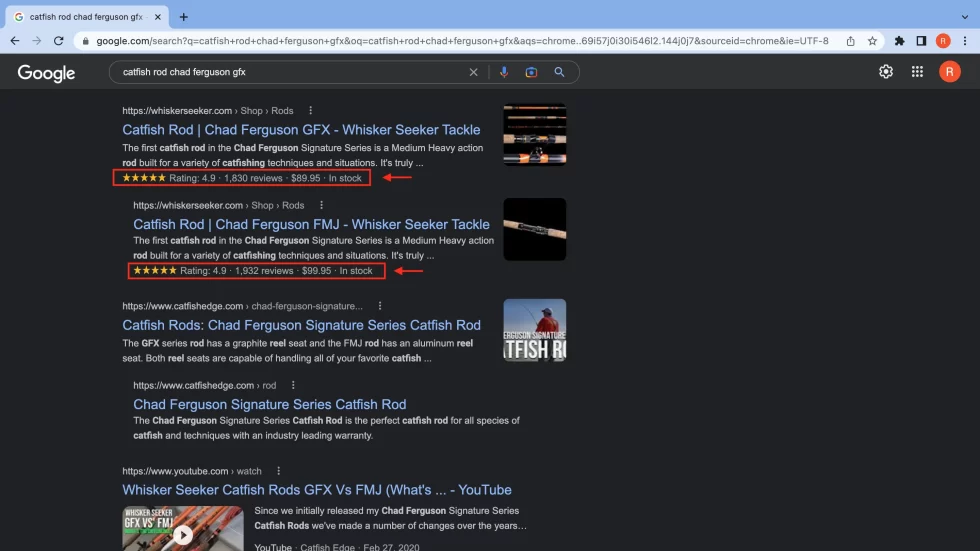Rich snippets are small, informative pieces of content that appear alongside Google’s organic search results. Rich Snippets were initially introduced by Google in 2009 to provide immediate context about product reviews, local businesses, and events.
Although Google’s Rich Snippets have expanded into different categories like recipes, courses, and articles, this article is focused on Product Snippets and how they can help eCommerce stores’ product listings.
Google’s Product Snippets are very recognizable – you have probably seen hundreds of products with them.

Whisker Seeker has structured data implemented on their product pages
Product Snippets include:
- Product Reviews
- Product Pricing data
- Product Ratings
- Product Availability
If you’re wondering how Google displays those snippets about your product, it’s not magic!
Google reads the relevant structured data on your product pages, this is typically referred to as product schema. Structured data and product schema might sound intimidating, but they’re simply a way to provide machine readable information about your product to Google and other search engines.
If your product data is not in a structured format, Google will pass your product like a bus that doesn’t see passengers at a bus stop.
This article will cover why Product Snippets are so beneficial to Ecommerce stores and how you can get started with structured data. By the end of the article, you’ll be able implement structured data on your products and help Google produce Rich Snippets for your product.
Somebody call the Black Eyed Peas, because it’s time to get started.
Why rich snippets are essential for eCommerce stores
Consider your eCommerce’s store’s decision to set up your products for rich snippets like a game of Rock Paper Scissors:

- If your competitors’ products have product snippets and you don’t = you’ll lose out on your lead’s first click on Google’s SERP.
- If your products’ have product snippets and your competitors don’t = you’ll beat them to your lead’s first click on Google’s SERP.
- If you and your competitors’ products both have snippets = you both tie, but whoever has the better reviews, pricing, stock, and delivery time will likely win the first click on Google’s SERP.
Okay, but how do you know rich snippets and structured data are really that important?
Rich Snippet Data – Higher CTR and Better Conversion Rates:
- In 2019, Episerver (now Optimizely) surveyed more than 4,500 consumers about their online shopping habits and expectations. Google was also the starting site for shoppers searching for product inspiration (32%.) Google was the starting site for shoppers searching for a specific product (31%.)
- According to Moz, companies have seen a 20-30% increase in SERP click-through rates after using structured data for rich snippets.
- Catalyst ran a test after implementing structured data for rich snippets and found that clicks from SERPs to their site increased by 150%.
- After StyleCraze applied structured data for their how-to articles, their click-through-rates increased by 20%.
- Monster.com saw a 94% increase in organic traffic after using structured data to display rich snippets. More importantly, they observed a 10% increase in job seeker applications. Woah!
- Raukten observed a 150% increase in session duration after applying structured data to their recipe pages.

To summarize the data:
Google is typically a consumer’s starting point for both product inspiration and product searches.
Product Snippets give searchers rich context about products, therefore increasing your product listing’s click-through rate.
Searchers stay longer on pages that have snippets, boosting your conversion rate.
The only reasonable conclusion is that eCommerce stores that have rich snippets next to their products are at a distinct advantage compared to those that don’t.
If your eCommerce store’s product do not have structured data, Google can’t read all information about your products and won’t be able to display your Product Snippets!
Let’s talk about implementing structured data for your eCommerce store.
How to implement structured data for your eCommerce products
If you Google “product snippets for eCommerce products” there is going to be a lot of complex, outdated advice. Our goal is to make this simple for you.
We will define structured data terminology, summarize the outlines that Google has produced for you, and help you with clear next steps.
Rich Snippet Terminology for Ecommerce stores
- Structured Data = Google defines this as a standardized format for providing information about a page and classifying the page content.
- Schema.org = This organization was founded by Google, Microsoft, Yahoo and Yandex to create, maintain, and promote schemas for structured data on the Internet. Think of Schema.org as the United Nations of structured data for the Internet, although they’re not technically a formal organization. Google, Microsoft, Yahoo and Yandex all have to agree upon the same structured data, that way your Ecommerce store doesn’t have to implement structured data for each search engine. It’s really a fantastic organization. Hats off to them.
- Web Crawler = When Google examines your products, it is doing so with fully automated software that reads your site markup. Just to be clear, there is not a Google employee looking your products up and down. Google’s web crawler is called Googlebot.
- JSON-LD = this is Google’s recommended structured data format for your eCommerce store, although you can also use the RDFa and Microdata formats.

Step by step guide for adding structured data to your product pages
- Watch Google’s search team’s explainer video on structured data to cement your understanding of structured data.
- Make sure you are using the Google Search Console. This is a helpful tool that will alert you to structured data errors on your site.
- Using the Google Search Console, make sure Google can crawl your website, i.e. – Googlebot isn’t blocked.
- Use a Rich Snippets plugin like RaveCapture for your Ecommerce platform. This will greatly reduce the complexity of adding structured data to your Ecommerce store. With TrustSpot, you can sit back and relax while our software adds structured data to your product pages. RaveCapture’s Product Widget automatically produces the following structured data for Google’s webcrawler:
- Product Schema – Name, URL, Image, Description
- Offer Schema – Price, Currency
- Rating Schema – Overall rating value, Review Count
- After you have implemented your structured data, access the Rich Results test tool and verify that your product page supports rich snippets.
- Explore the search gallery and see if there are other rich snippets that might apply to your Ecommerce store.
That’s a wrap on rich snippets!
Well, we hope that was a helpful article. If you have any questions about how your eCommerce business can implement structured data for product snippets, we would be happy to help.
Get Started Today with RaveCapture!
